Alert: Unguarded rotating trolley track hoist drums
Learn about the rules and regulations to reduce risk of injury or death when operating trolley track hoists.
Issued: November 9, 2015
Workers have been injured while operating portable trolley track hoists. Typically, these hoists are equipped with guards over the drive belt and brake components of the hoist, but are not guarded or fenced to prevent a worker from accessing either the rotating hoist drum or the pinch point between the drum and the cable.
This hazard alert is intended to help workplace parties, including manufacturers and suppliers, be aware of the drawing-in (in-running pinch point) hazard on trolley track hoists that do not have a fixed guard or barrier to prevent a worker from exposure to either the rotating hoist drum or the pinch point between the drum and the cable.
Trolley track hoist
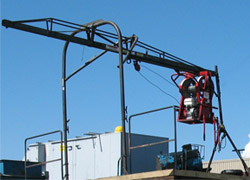
Side view of trolley track hoist
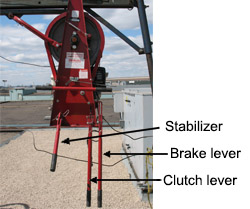
Hazard summary
Drawing-in hazards (also called in-running nip, or in-running pinch point) are created between two counter rotation objects, a rotating object and a stationary object or material wrapping around a rotating cylinder. With trolley track hoists, the drawing-in hazard is created by the cable wrapping around the hoist drum. The pinch point is considered the point where the cable contacts the drum. Usually this means the operator’s fingers can be pinched between the cable and the hoist drum as the cable wraps around the drum.
As required by the Construction Regulation (Construction Projects, O. Reg 213/ 91) “Every gear, pulley, belt, chain, shaft, flywheel, saw and other mechanically-operated part of a machine to which a worker has access shall be guarded or fenced so that it will not endanger a worker” [section 109].
Hoist drum – spool on the hoist onto which the cable is wound
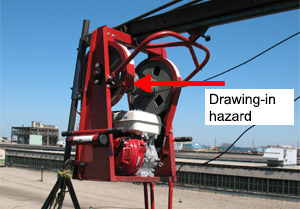
The Occupational Health and Safety Act, requires employers to acquaint a worker or a person in authority over a worker with any hazard in the work and in the handling and use of any equipment [Section 25(2)(d)]. Therefore, employers must identify the drawing-in hazard to workers or a person in authority over the workers. Pursuant to section 109 of the Construction Regulation, an employer must guard or fence the hoist to prevent workers from coming into contact with the cable as it is wrapping around the hoist drum. In these situations, guards are used to prevent workers being exposed to hazards from moving parts on machines.
Protective measures
In the case of the trolley track hoist, the operator can be protected from the drawing-in hazard between the cable and the reel using one or more of the methods that follow. The examples below may not be applicable in all circumstances. For example, methods 2 and 3 protect only the operator, not other workers who may be working in the vicinity of the hoist and could be exposed to the drawing-in hazard. A manufacturer of this type of hoist has stated that unhooking a load requires a second worker in addition to the operator. The operator releases the brake while the second worker slackens the hoist cable. If there are workers exposed to this hazard other than the operator, a guard or fence protecting all the workers is required by section 109 of the Construction Regulation.
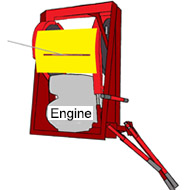
Method 1: Guard the hazard area in front of the reel – fixed guard example
A fixed guard attached to the front of the reel can prevent the operator from placing his or her hand close to the hazard and other workers from being drawn in to the pinch point. A fixed guard cannot be removed without tools. (This is an example; the size is not to scale.)
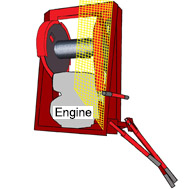
Method 2: Barrier on the power pack – only applicable if the operator is the only worker exposed to the hazard
A fixed guard attached to the front of the reel can prevent the operator from placing his or her hand close to the hazard. A fixed guard cannot be removed without tools. (This is an example; the size is not to scale.)
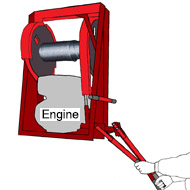
Method 3: Two-hand control – only applicable if the operator is the only worker exposed to the hazard
Normally, to raise a load the operator pulls up on the clutch lever, which in turn lifts the brake lever; only one hand is required to drive the reel. The left hand is normally on the stabilizer to keep the power pack from swinging. The controls could be designed such that the drive is activated with two levers simultaneously, forcing the operator to have two hands on the controls. This type of safeguard only protects the operator.
Two hands must be used to drive the reel to raise a load.
For more information
Call our Health and Safety Contact Centre toll-free at 1-877-202-0008 or visit:
This resource does not replace the Occupational Health and Safety Act (OHSA) and its regulations and should not be used as or considered legal advice. Health and safety inspectors apply and enforce these laws based on the facts they find in the workplace.